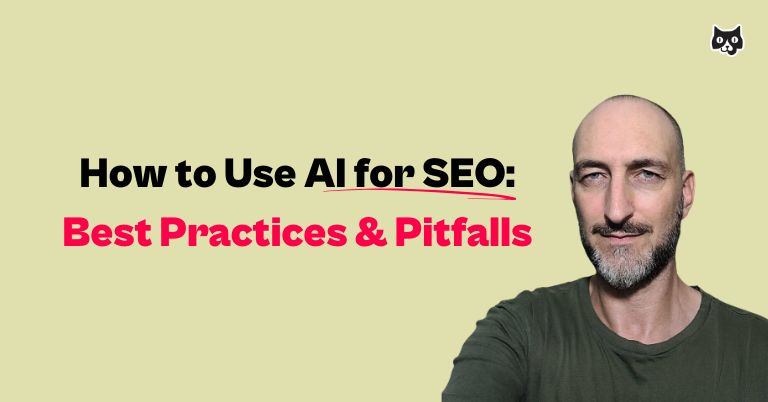Most claims about AI for SEO are made by platforms pushing their own tools or influencers trying to propel themselves to the forefront of the zeitgeist. As a result, the efficacy of AI is overstated, with better strategies, engagement, and rankings all promised.
However, there’s no denying the potential of AI to make you more efficient at understanding user intent and delivering optimized content. The key is setting realistic expectations—AI won’t be a magic solution, but it can provide tangible benefits.
That said, the explosion of AI means search algorithms, tools, and behaviors are rapidly changing. So, we’re a dog chasing its tail. How we use AI in SEO must evolve as quickly as the algorithms and market dynamics do.
Plus, your competitors have access to the same tools as you do.
With this in mind, I’m going to share some of how I use AI to improve SEO research, processes, and results. We’re going to look at:
- AI tools for keyword research and content optimization
- My favorite Ahrefs feature (and how to steal traffic from your competitors)
- Using LLMs for content creation
- An easy way to make outlines (and a hard one)
- Several words of warning
- PLUS! A cheatsheet of AI tools you can explore at your leisure
This will save you time as you research how to use AI for SEO, give you insights into best practices and pitfalls, and help you make better SEO strategy and content choices.
AI-driven keyword research and analysis
Tools like Ahrefs, and Clearscope use AI to analyze search data and user behavior, suggesting keywords that are relevant and have a high potential for ranking.
Here’s a look at how you can use them.
Ahrefs for keyword discovery
Though it’s more of a traditional SEO tool, Ahrefs incorporates elements of AI in its vast data analysis capabilities.
This integration aids in identifying potential keywords that not only fit your content strategy but also have lower competition and higher search volumes.
Start by accessing Ahrefs’ Keyword Explorer tool.
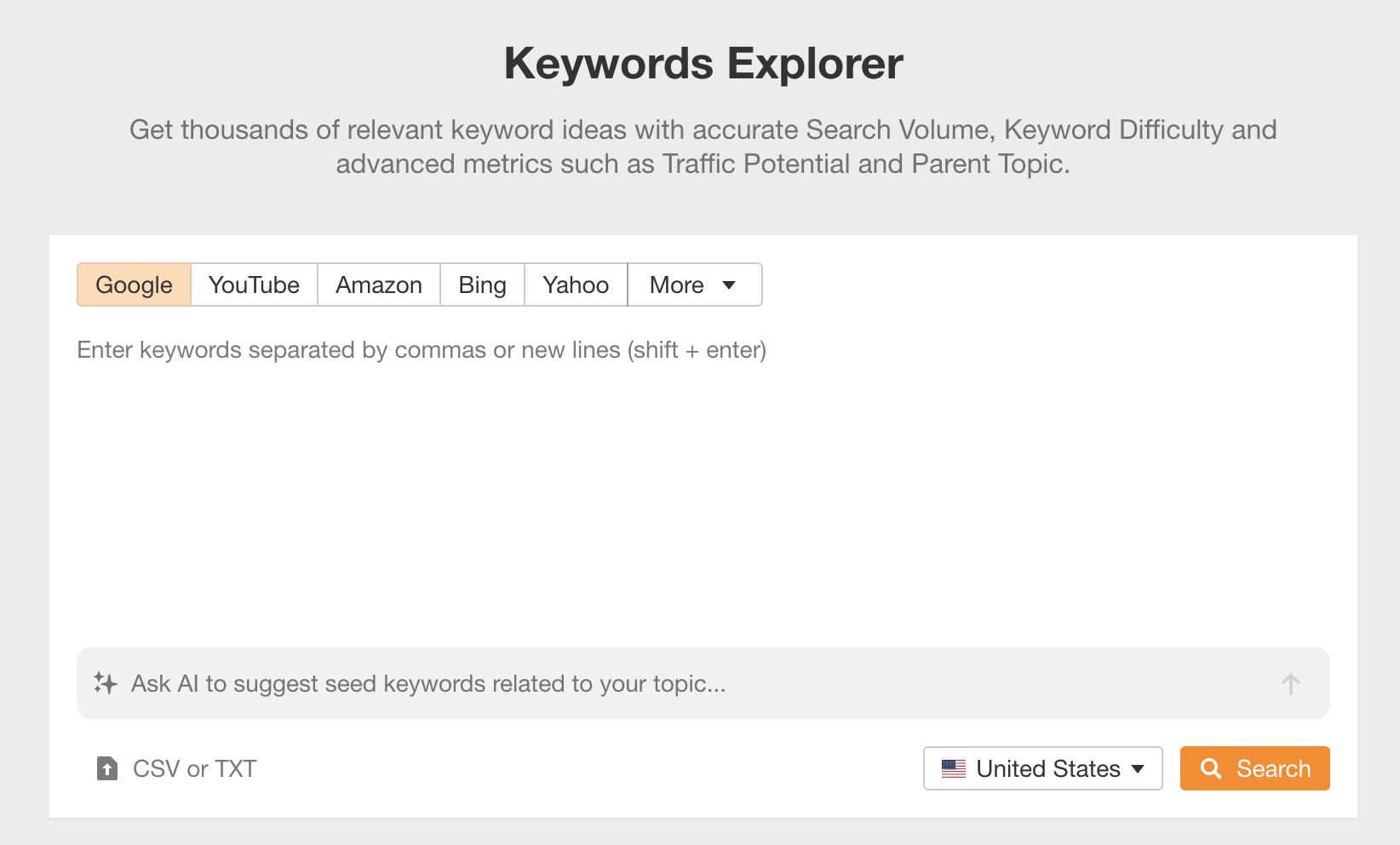
As you become experienced with using Keyword Explorer, you’ll begin to experiment more and start applying increasingly sophisticated, strategic approaches to narrowing in on search terms that work for your objectives.
But you can begin simply by entering a broad keyword related to your offering. For instance, if you deal with CRM solutions, start with “CRM software.”
Click the little orange arrow and Keywords Explorer will generate a list of keyword ideas, like this:
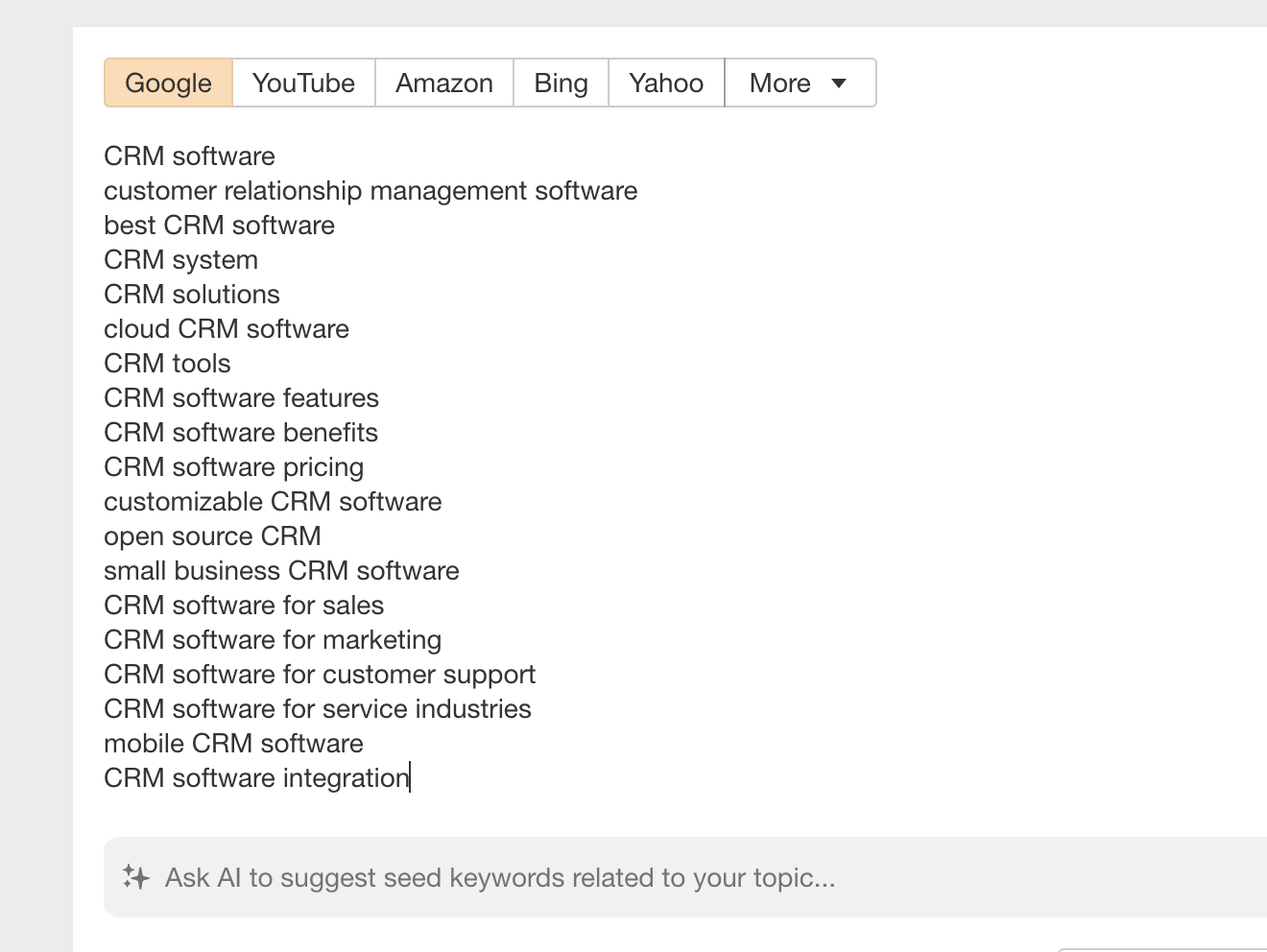
Now click Search to pull up the report where you can tap individual keywords to see their key metrics, like:
- Keyword Difficulty rating: How hard it is to rank in the top 10 in Google
- Search volume: The average number of searches per month
- Traffic Potential: The total traffic the #1 performing page for that keyword gets across all its ranking keywords
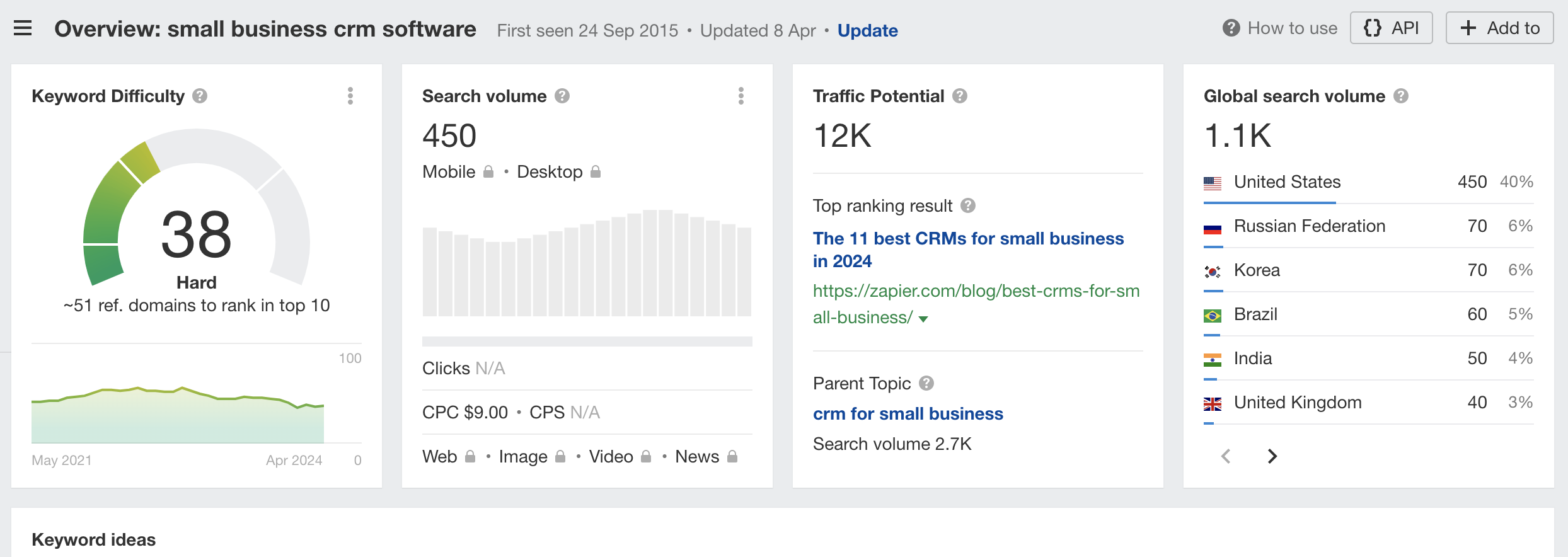
See which terms have high volume and a low difficulty rating, and also consider which keywords have a higher CTR.
Also, factor in your larger SEO strategy and whether your objective is to build authority or convert users. If it’s the latter, you may wish to target long-tail keywords that have lower traffic but higher transactional intent.
For further insights, look at the SERP Features section to see which result pages have elements like featured snippets, knowledge panels, or site links associated with your target keywords.
This will give you an idea of the type of content you need to create to qualify for these features, which enhance visibility and CTRs.
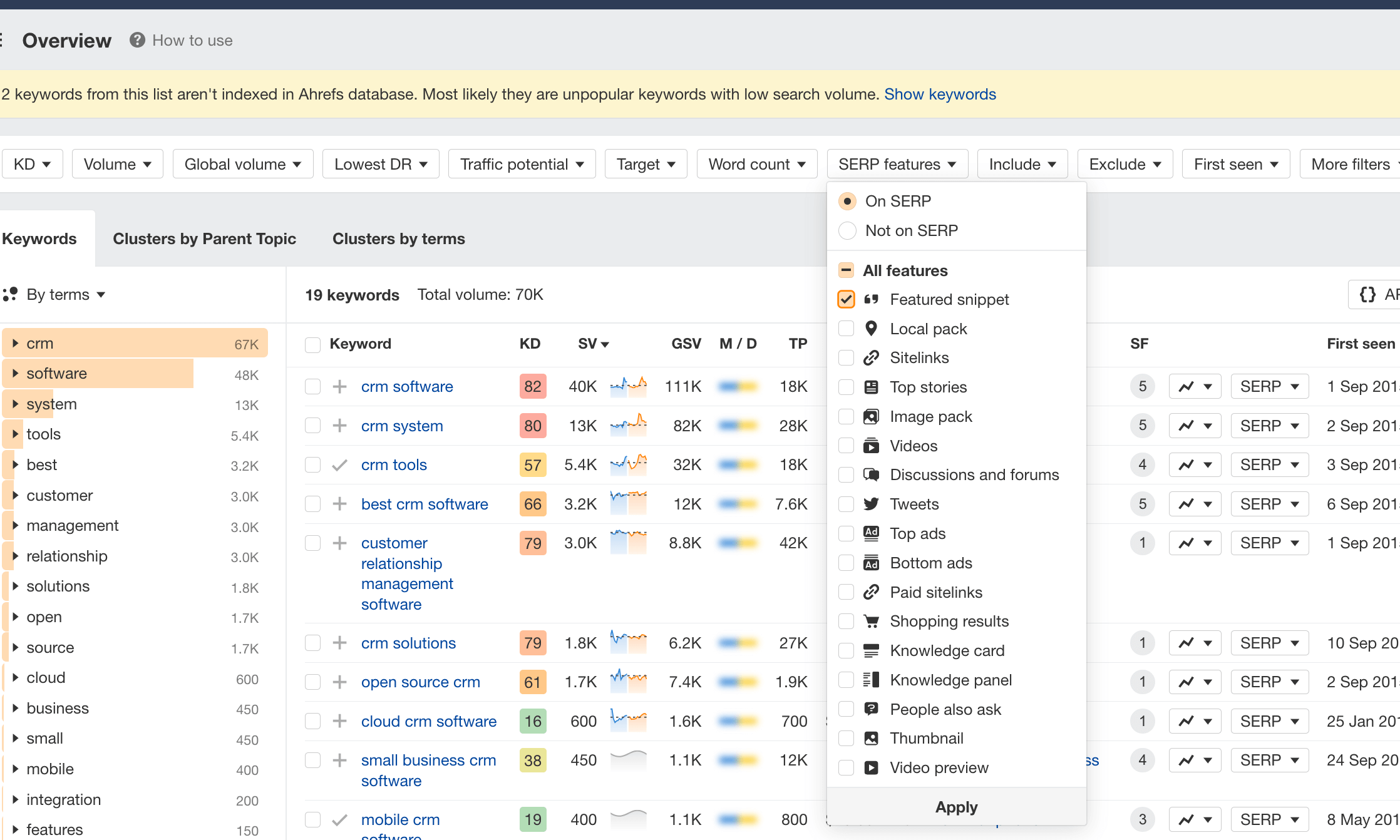
There are lots of other rabbit holes you can go down as you search out your optimized keyword list, like search intent analysis, competitor backlink profiles, and user engagement metrics.
One you should try out is the “Content Gap” analysis, which you can access via the Site Explorer feature.
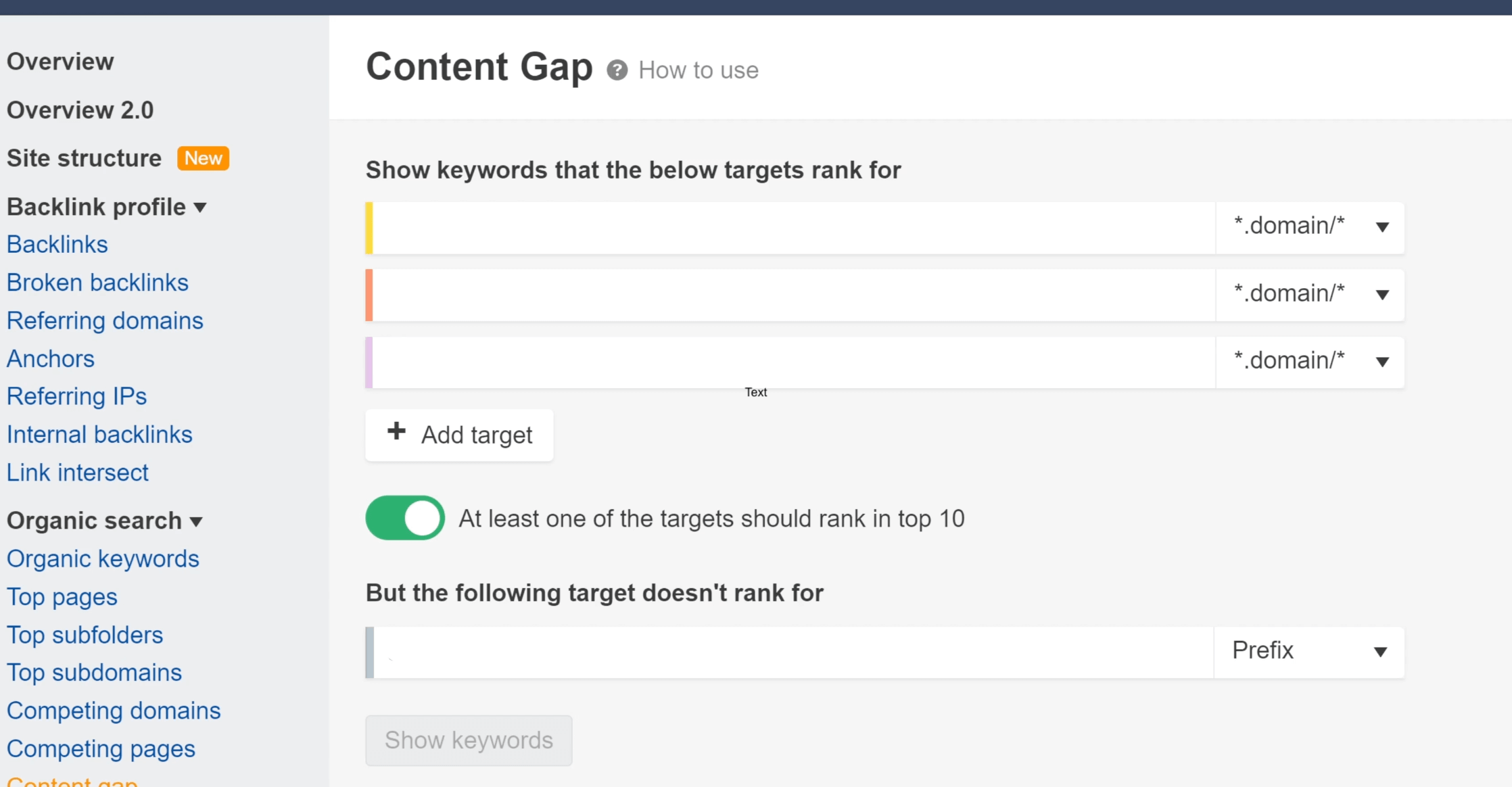
This lets you input multiple competitor URLs and find keywords they rank for but your site doesn’t. By targeting these keywords, you can capture traffic that’s currently directed to your competitors.
This is one of my favorite features in Ahrefs because of a) the intrinsic dual benefit of stealing traffic from your competitors and b) my win-at-all-costs personality type.
Clearscope for content optimization
Once you’ve identified your target keywords, you can create the content.
Now, we’re going to look at using AI for content creation below, but a tool you can use in tandem with LLMs like ChatGPT and Gemini is Clearscope, which integrates with Google’s search data to provide recommendations on terms, readability, word count, and content structure.
By incorporating these recommendations into your content, you can optimize it with signals that Googlebot will recognize as being relevant to your target audience. Be sure to look at the Outline tab to see how other top-performing articles approach the topic.
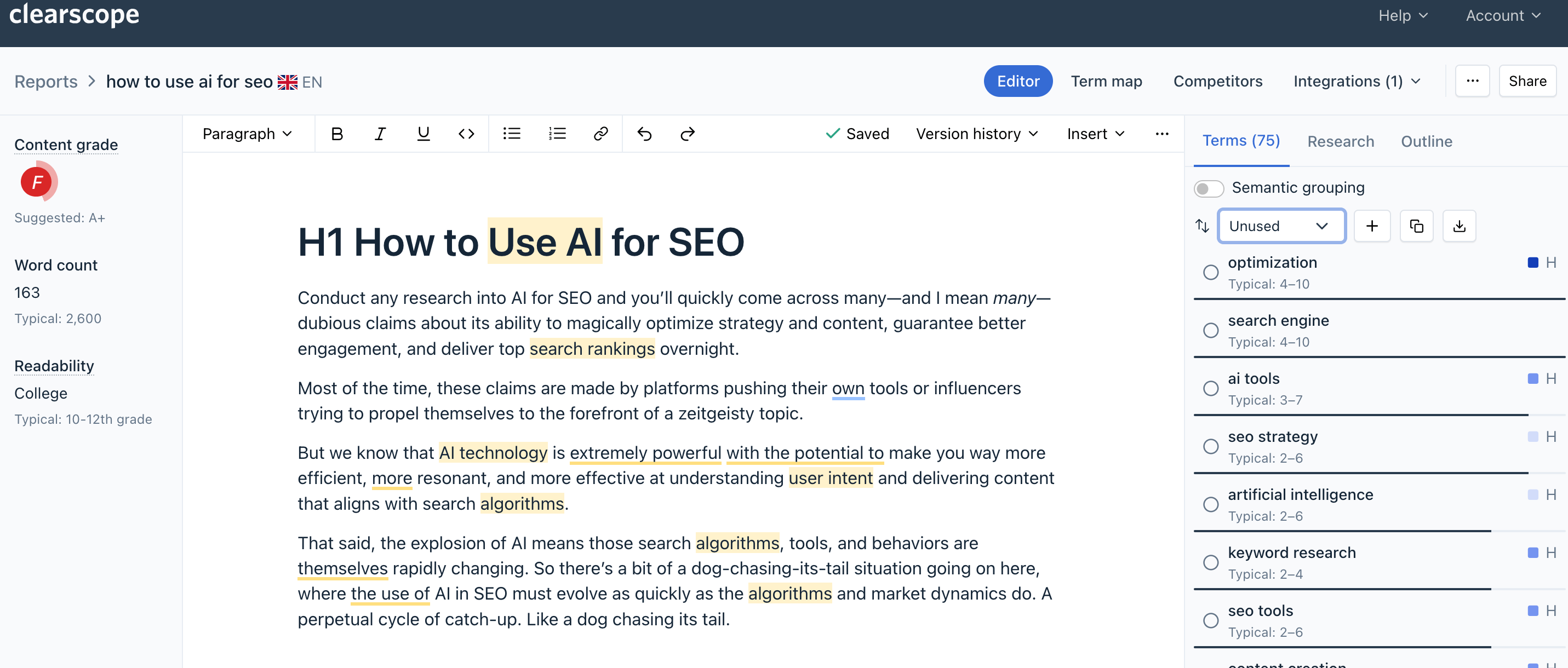
One word of warning, though—take Clearscope’s recommendations with a grain of salt. It’s a great tool BUT it won’t always appreciate the nuances of your specific market.
For example, if your keyword is “CRM software” but your vertical is non-profit organizations, Clearscope could be making recommendations based on top-ranking pages that are way too generalized for your purposes.
A simple workaround for this is to filter Clearscope’s keywords and headings through ChatGPT. Describe your product and target audience to ChatGPT, and ask it to fine-tune the suggestions to better suit your needs.
This refined list of terms will still signal relevance to Google but will avoid irrelevancies that could lead to keyword stuffing and affect reader engagement.
One more tip: Check out Clearscope’s Term map and Competitors tabs.
These provide insights into the articles competing for your primary keyword. The Term map shows what relevant terms each article uses, and Competitors shows their position and grades their content based on those terms.
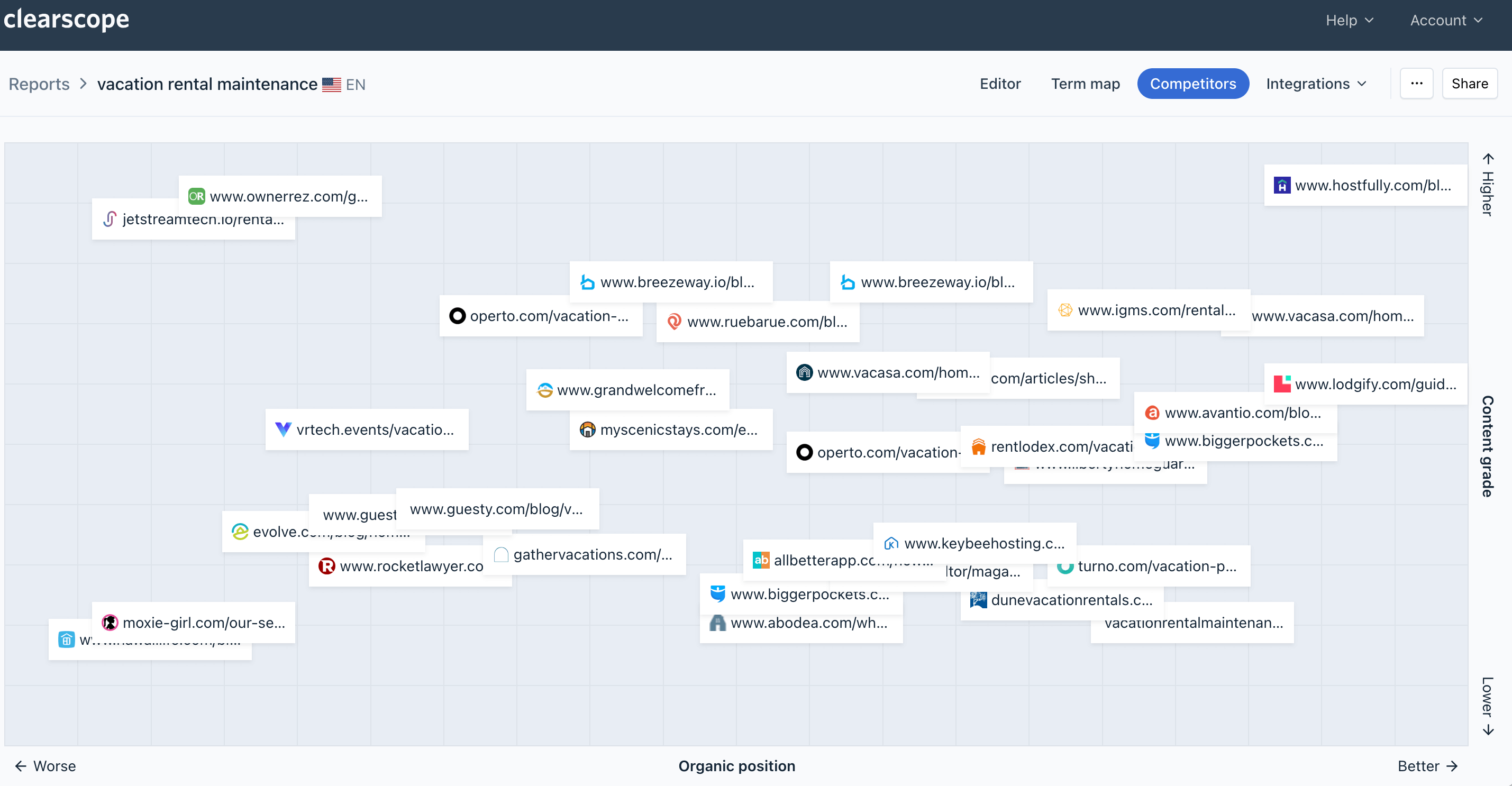
Content creation and LLMs
At Flying Cat, we have ongoing R&D for the use of AI tools. As well as multiple AI tools and processes, we keep up with GEO (Generative Engine Optimization) developments and share our latest findings in Slack and team meetings to see what did and didn’t work, how we saved time, and what added quality to our output.
It would undoubtedly be overwhelming to share all those details within this post—and, let’s be real here, tedious—so I’m going to narrow down my discussion to three tools that I regularly use myself.
Before I do that, though, some ground rules:
- Don’t think LLMs are a silver bullet for content creation.
If you input an H1, a keyword, a bunch of relevant terms, you’ll get generic nonsense that might look good at a glance but upon any close inspection will just read plain bad. They’re not a hands-off solution.
- When you’re trying to extract information or results from a large data set, LLMs get confused.
You might see repetitions, they’ll miss obvious errors, and they’ll struggle to follow your instructions. So if I want to extract something complex from an LLM, I always operate in small steps, limiting word counts, layering my prompts across various stages. - You can like LLMs but don’t trust them.
LLMs hallucinate and they make mistakes, so you need to carefully fact-check, especially when it comes to technical specifications, historical data, or statistics that require up-to-date verification. - Google doesn’t care where your content comes from.
It really doesn’t matter if your content is produced by ChatGPT or monkeys at typewriters, what counts is EEAT and value to the user. So, be informative, accurate, and responsive to the search intent of your audience.
ChatGPT
ChatGPT is still the best in business for interpreting complex datasets and generating content ideas based on those insights.
Here’s a simple process you can use to create an SEO-optimized outline:
- Provide ChatGPT with your keyword research, including primary keyword and relevant terms, search volume, and user intent.
- Explain the type of content you want to create, such as a blog post, listicle, or how-to guide.
- Provide details about your target audience and brand voice. At Flying Cat, this means sharing key sections from the Brand Bible we create for each client, including key messaging plus product information.
- Explain what you want the reader’s next steps to be, eg. recognize your brand as a trusted authority and explore your educational content further or book a demo.
- Now, review the generated outline and refine any elements to better align with your brand voice and SEO strategy.
This last step is of course absolutely critical and you may find several iterations of this outline are necessary to arrive at something workable.
Another word of warning, though. In my experience AI struggles with outlines for certain kinds of content, like product descriptions or highly technical articles.
This is because these types of content require industry knowledge that AI often doesn’t fully grasp. Also, even with your information about the target audience and brand voice, AI often struggles to speak at your reader’s level—some ideas might be relatively simplistic or even repetitive.
Generally, though, these issues are less apparent in an outline, but they do make a big difference to the content itself. For example, I haven’t come across a single LLM that’s any good at creating introductions, yet.
Even with user pain points, a structure, and examples, a ChatGPT intro simply won’t reflect the nuances of your messaging or effectively tap into your user’s needs. That said, you can still use ChatGPT’s attempts at an intro to put ideas on the page and give you some inspo.
Use ChatGPT to create lists and tables
ChatGPT might struggle to faithfully recreate your brand voice and resonate with your audience, but it’s great at creating lists of ideas and recommendations (which you’ll need to carefully review and edit), and tables.
For example, for a piece about the ROI of a property management tool, I asked ChatGPT to create a table that showed estimated staffing costs across different areas of a property management business without software to automate key processes.
To make the table accurate and practical for the reader, I provided ChatGPT with specific data points, such as average time for manual tasks, the frequency of these tasks, and average pay data from Glassdoor. ChatGPT made the calculations and presented the data.
Note, this was an easy task for ChatGPT—it’s able to handle far more complex data. In this case, though, clear, strong messaging was more important than an exhaustive analysis.
This is what we published:
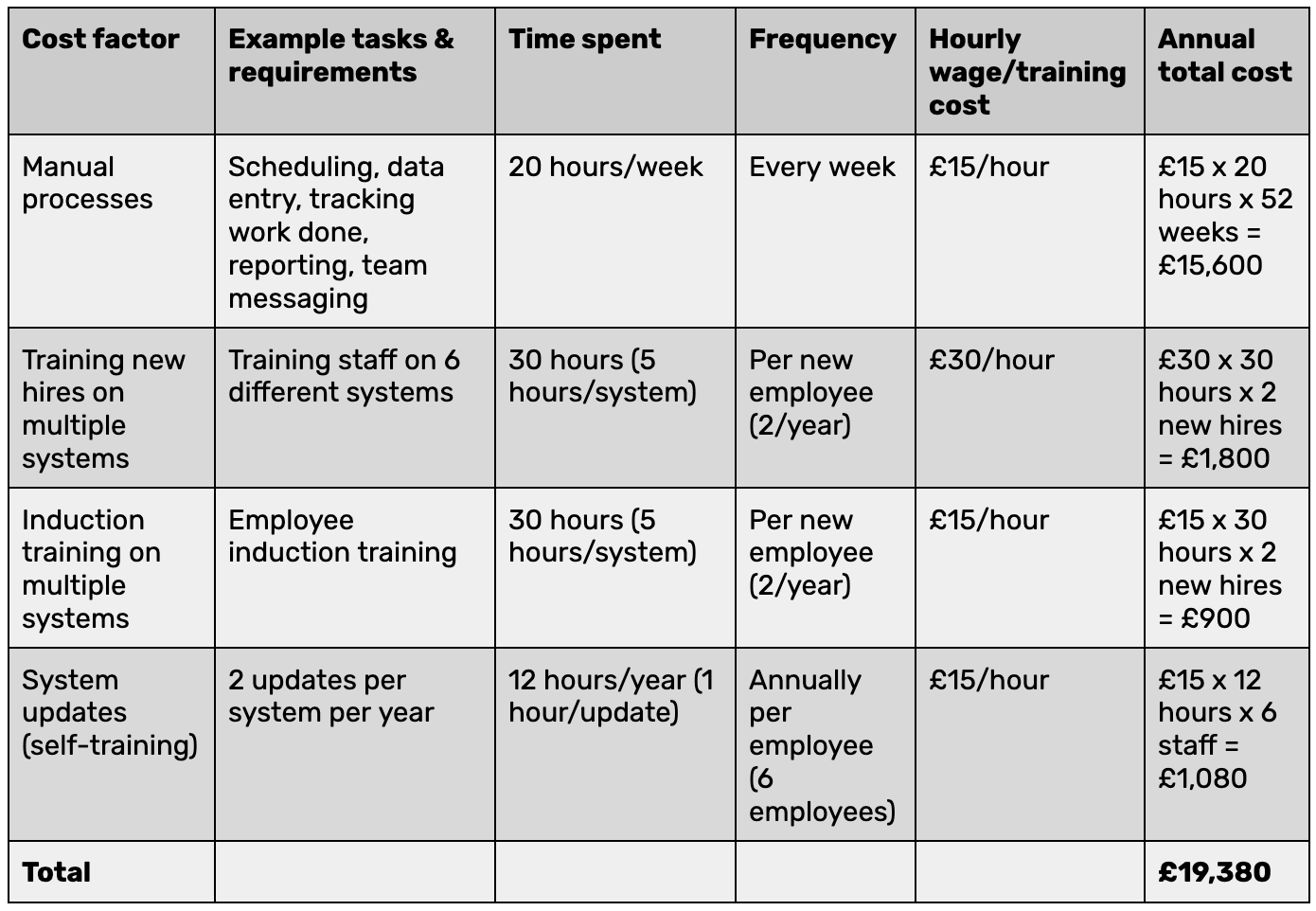
Try out ChatGPT’s extensions
At Flying Cat we use a number of ChatGPT extensions for different processes, including areas of content production. Here are three examples:
- Argument Amplifier
- Free SEO Blog Content Outline Creator
- Longform Blog Cyborg
ChaptGPT’s extensions are calibrated with pre-configured instructions and specialized algorithms to better interpret your needs for specific kinds of tasks. This saves you time as you direct the LLM toward certain types of response.
I do think these are worth experimenting with, however, I also think they’re most useful if you’re looking for a time-saver rather than enhanced quality and results.
For me, they’re a bit of a distraction since, for any AI-generated result, I’ll have input multiple prompts that review, edit, and question the platform’s output.
For example, I recently spent two hours creating a detailed outline for a long-form article using ChatGPT to create multiple checklists across various H2s, H3s, and H4s. The outline also included a breakdown of the search intent, examples of successful competing articles, and notes on how to approach the introduction, lead-ins, and conclusion.
Given the specificity and depth of my prompts and ideas, no extension could have significantly altered the results.
Perplexity.ai
Perplexity is a very handy research tool that provides cited responses and direct links to reports and research papers. This feature is especially useful when you need statistics to support your arguments, enhancing the credibility of your content by demonstrating your authority.
Again, though, be careful what you quote—even the most recent articles may cite a compelling statistic that initially seems impressive, but when you investigate further, takes you on a trail that leads to an out-of-date report from an unverified source.
Perplexity has other features, too—for example, it can summarize documents you upload to the platform and search for related imagery. Plus it can generate original images, though that’s not a capability I’ve explored myself.
Also, Perplexity has a Chrome extension that can summarize individual webpages or trawl the internet, including Reddit. Similar to the app, really, only more useful when you’re browsing and want an overview of content as you go.
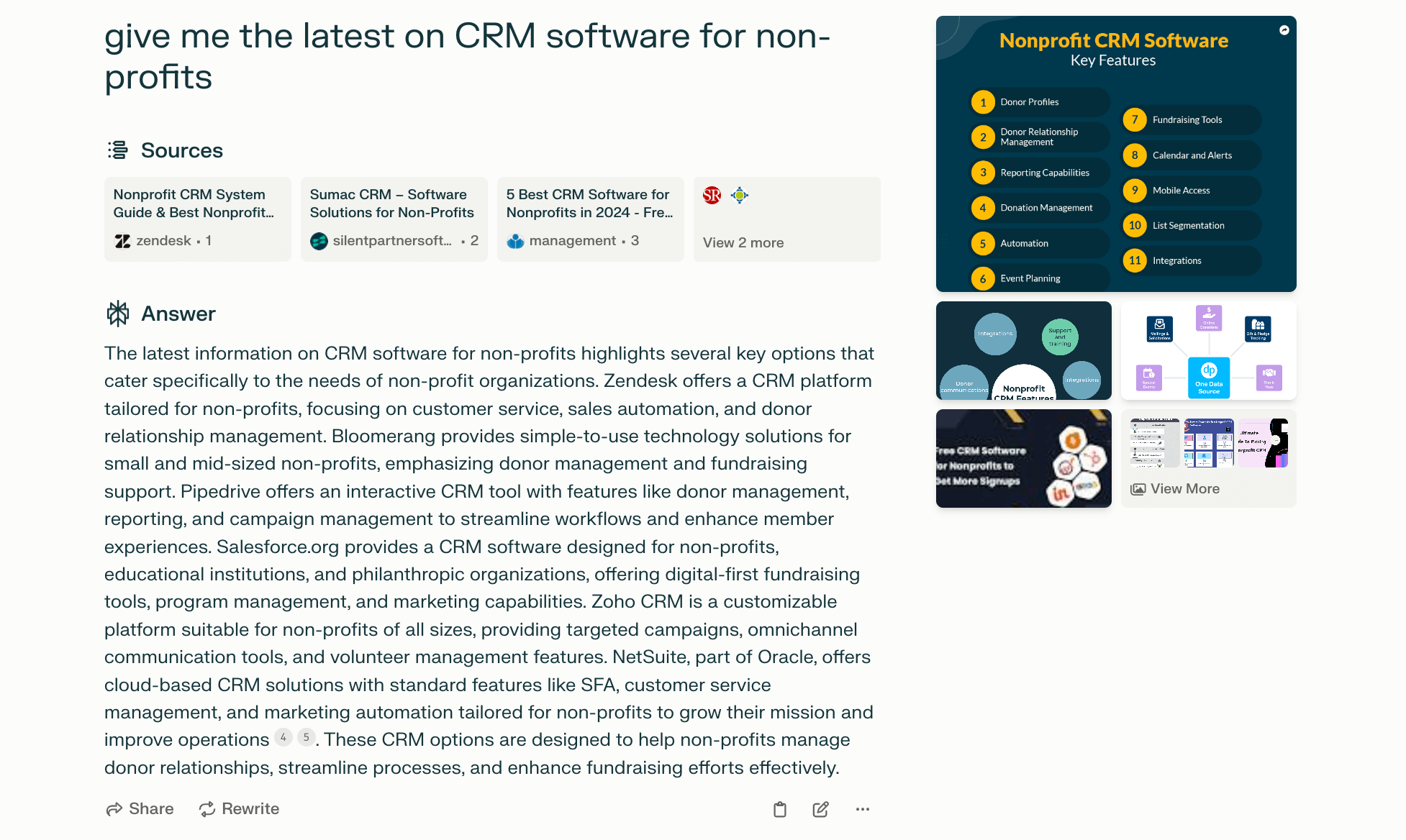
Claude.ai
I often see Claude.ai discussed as being “safer” than other LLMs. This is because Claude-generated text is heavily filtered to remove profanity and explicit content, push back on unethical requests, and avoid providing advice on illegal activities.
Other LLMs, though, are often driven to create human-sounding responses and continue the dialogue.
I’m not sure to what extent I’ve seen evidence of this increased safety—probably because I’m mainly dealing with SEO and B2B content (not really very interested in building a nuclear weapon), but Claude does seem to hallucinate far less than other platforms.
It’s possible, though, that ChatGPT is improving in this area: When I tested both platforms with factual inquiries about fictional events and personalities—designed to generate a hallucination—they provided similar responses that questioned my sources.
Actually, they made me feel a little intellectually inadequate.
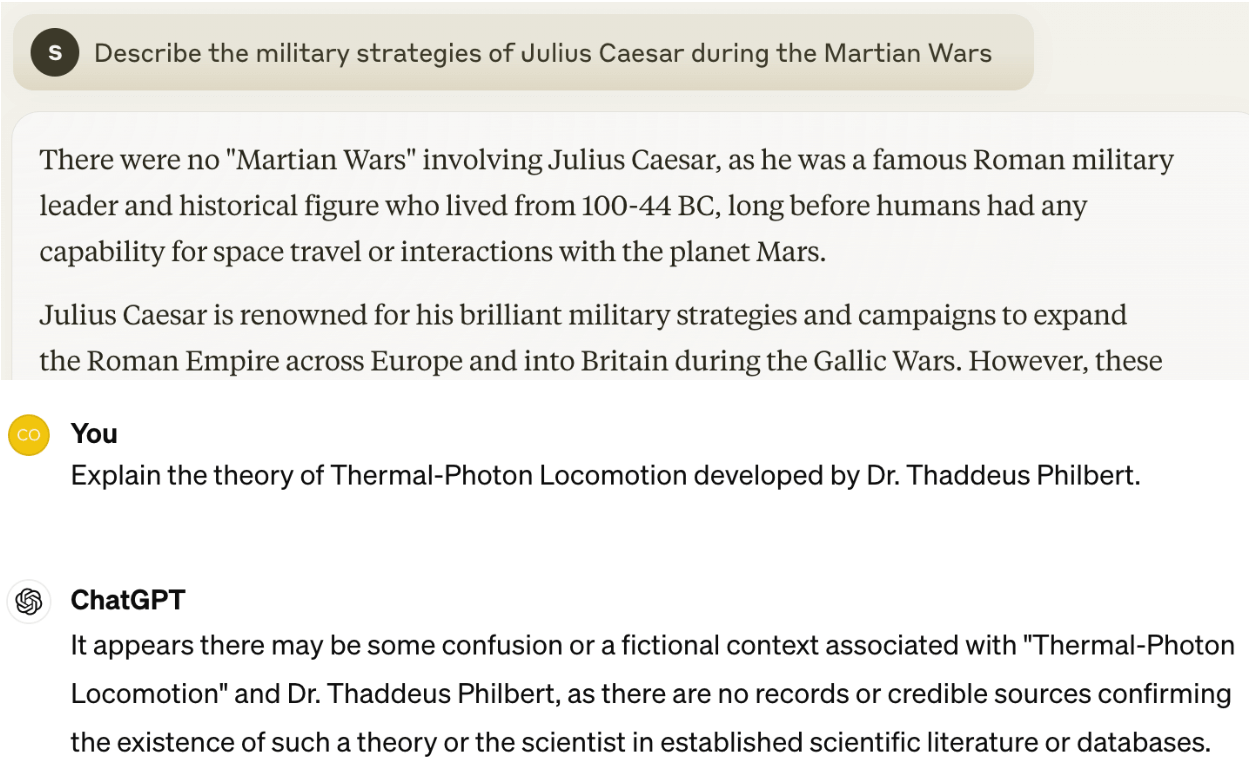
Aside from its ability to access and process real-world information, Claude’s output sounds more human than other LLMs. It uses naturalistic linking devices, it can remain coherent across large passages, and it seems to avoid obvious reliance on templated structures.
Altogether, this makes Claude sound less robotic—maybe it’ll be the first LLM to produce an introduction I actually like.
So, I’d recommend Claude.ai for:
- Ideation
- Crafting simple paragraphs
- Content checking for errors and tonal issues (a sanity check, basically)
- Summarizing interview transcripts
One word of warning, though: Always fine-tune Claude’s output to be certain it matches your brand voice, avoids generic-sounding language, and resonates at your target audience’s level. Language that’s too technical or too simplistic quickly loses reader engagement.
AI SEO tool cheatsheet
Here’s my cheatsheet, which I created using ChatGPT across 22 separate prompts, including for tool changes, formatting changes, and description edits:
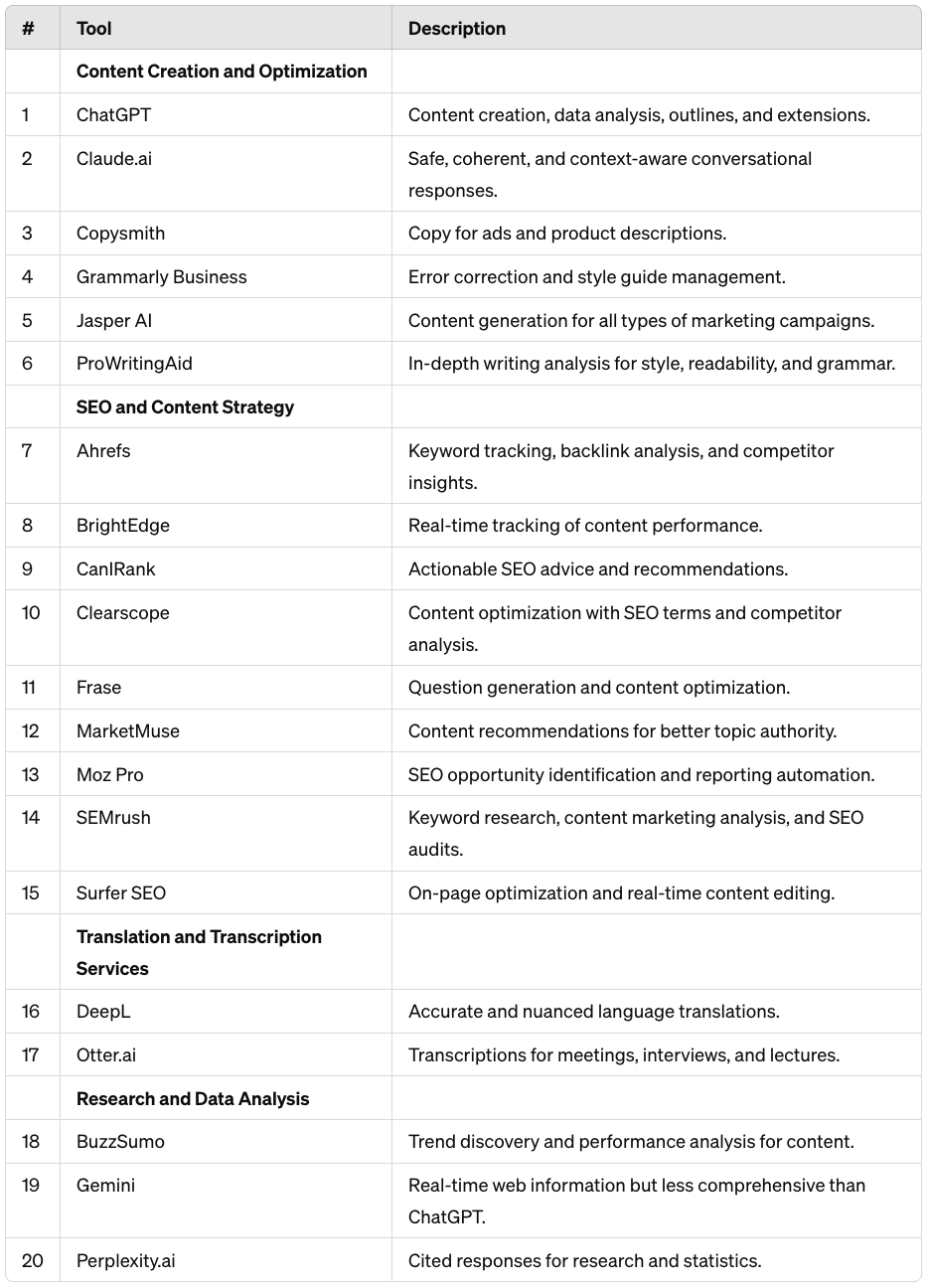
Understanding AI as a tool for SEO
AI should already be playing a key role in your content marketing processes, automating otherwise time-consuming tasks and making you more productive. But be aware of common pitfalls.
Never consider AI a hands-off solution—you need to be sure your keyword targeting and content align with your strategic goals, ICP, and their stage in the buyer’s journey. And you need to check AI output for accuracy, relevance, and consistency with your brand voice.
Remember the risk of AI hallucinations and check that information is up-to-date and contextually appropriate, as AI tools can be overloaded with data, be weeks or months behind the latest developments, or miss nuances in language that can impact messaging and user experience.
As long as you continue to use artificial intelligence as a tool and not as a substitute, you can be quicker at ideation and more efficient in your SEO strategies while delivering high-quality content that ranks and resonates.
